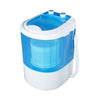Blood, Fresh & Dried
Rinse fresh blood stains in cold running water and rub with soap. Repeat. For stain removal of dried stains, first scrape or rub off as much dried blood as possible. Soak in warm water using a product which contains enzymes. Wash. If this doesn’t work, rewash the item using a chlorine-free bleach. In the case of stubborn stains, rust removers may be helpful.
Coffee, Tea
Presoak item in liquid detergent with bleach. Wash using the hottest water temperature that is safe for the fabric.
Cosmetics
Dampen stain and rub with liquid detergent. Rinse, then wash.
Dingy White Socks
Presoak in a liquid detergent solution for a minimum of 30 minutes. Wash in a liquid detergent which contains oxygen bleach. Food Coloring Soak in cool water. If stain remains, rub on detergent and rinse. Wash.
Fruit Juice, Wine & Soft Drinks
Soak stain in cool water as soon as possible. Then, soak in an oxygen bleach, using the hottest water safe for the fabric. Wash.
Mud
Brush off as much as possible when garment is dry, then rinse under cold running water. Pretreat with a paste of powder detergent and water, or liquid laundry detergent. Wash using laundry detergent and a fabric-safe bleach.
Rust Stains
The yellow, orange or brown spots we sometimes find on our clothes may be caused by rust. Iron content of over .2 parts per million in your water supply can cause these type of stains, so it’s important to have your water supply checked. Two possible sources can be rust water pipes or water heaters. One way to combat this problem is by using a mechanical water softener with an iron filter. Also, using a non-chlorine bleach can help, as chlorine bleach may cause the iron in the water to precipitate on fabrics and leave stains.
Washing Tips Read very carefully if you have a septic system!! Your laundry habits can ruin your septic system if you are not careful. Lint from washing machines is one of the leading causes of expensive septic system failure. Fortunately there is a new invention called the Filtrol 160 which hooks up to a washing machine and solves this problem by catching lint at the source. In addition to using a lint filter to prevent this problem, it is also very important to avoid overloading the system with water. Spread out your laundry loads, i.e. don’t do all your loads on Saturday morning. Also, make sure to wash your clothes with a liquid detergent, powdered detergents often contain fillers which can plug up the drain field and lines. For more information on septic system maintenance, you can go to http://www.laundry-alternative.com/septic_system_maintenance.html.
Brighten Colors with Salt
Hard water can cause clothes to become dull or dingy after several washings. To solve this problem, add a couple of pinches of ordinary table salt to the washer with the detergent. Let some water run in the washer to dissolve detergent and salt, then add clothes. Colored clothes will come out much brighter.
Delicates
Think you have to take that sheer voile blouse, beaded top, fringed silk shawl, or lace trimmed dress to the cleaners? Think again! You can clean these at home by simply tying the articles in a cotton pillow case, knotting it closed, and washing in cold water on regular cycle. Beads, sequins, buttons and delicate laces will not fall to pieces, and garments can be restored by steam ironing or steaming in the shower!
Laundry Tips for Diapers
Do you hate dunking diapers in the toilet? There is now a new invention called the Little Squirt which eliminated this dreaded task. It is is powerful sprayer that attaches to the water supply for your toilet. Instead of dunking, you simply spray the contents of the diaper into the toilet. More information and a picture is available at http://www.laundry-alternative.com/washing.html.
Down
As a general rule, down items should be cleaned twice a year- once before you start wearing them, and before you put them away after the winter season. Down can be washed or dry-cleaned, read your care label for instructions. You’re better off taking large items that require a lot of washer and dryer space (i.e. comforters) to the laundromat, which has larger machines. Be careful not to tumble dry down items at a temperature greater than 140F, or water-resistant shell fabrics can slow drying.
Laundry Tips for Odd & Oversized Items:
Stuffed Animals
Old stuffed animals can be salvaged. Place stuffed animals in a pillowcase, tie a knot in the case, and then place the stuffed animals in your wash machine on gentle or permanent press. You can even dry them. For best results, machine dry animals for about 20 minutes and then let air dry. Your child’s favorite stuffed toy may look like new.
Baseball Caps
To clean baseball caps without destroying their shape, place them on the top rack of the dishwasher and run through a complete cycle. * Large items such as bedspreads, comforters and king size blankets should be washed alone or laundered and dried in oversized machines, which are available in most laundromats.
Rayon
Q. Can you wash rayon items by hand or in the washing machine or by hand? A. The confusing part about washing rayon fabric is that two types of rayon exist: viscose and polynosic. The major difference is that viscose rayon becomes weak when wet, and therefore normally requires dry cleaning. Occasionally it can be finished so that gentle hand washing is possible. Blends with 30 percent or more polyester will provide enough strength for gentle hand washing or machine laundering. Polynosic rayon is an improved version with high wet strength. You can safely machine wash and dry it. How do you tell the difference? Unless information is provided on the label, or can be obtained by calling the manufacturer, you can’t. Machine washable rayons will have the term polynosic, the trade names Modal or Zantrel, or indicate machine wash and dry on the label. The term viscose on a label will be accompanied by a care label that indicates to dry clean. For best results, follow care label instructions.
Silk
Why Dry Clean Silk? Did you know that silk does not need to be dry cleaned? All you need to do is warm hand wash the blouse with some mild woolwash (normal detergents are the wrong pH for animal fibers like wool and silk). Then dry until it is just damp, roll it tightly and place in a sealed plastic bag then place that in the freezer. Then when it is frozen take it out and iron it.
Suds & Cleanliness
When soap flakes were used, a lot of suds meant good cleaning performance. However, the way laundry detergent is presently formulated, this is no longer true. Unfortunately, many people are unaware of this, and use excessive amounts of laundrydetergent.
Washing Time
Never set the washing time for over 10 minutes — most detergents have done all the work they are going to do by then– the rest of the time your clothes are just agitating in the dirty water. It may not seem like much, but you can save a quite a bit of money over time using this trick.
Water Temperature
Water temperature plays a key role in the washing process. Hot water offers the quickest, best form of cleaning, and should be used for the following items: Sturdy whites, colorfast pastels and light prints, cloth diapers and similar baby items, and heavily soiled clothes. Warm water removes wear wrinkles, helps reduce wrinkling in the washer, and minimizes dye loss. It should be used for permanent press, all colorfast dark or bright colors, nylon synthetics, polyester, acrylic and washable woolens. You may want to keep in mind that laundry detergents are formulated to clean best at temperatures above 60°F/16°C. Cold water may prevent sensitive dyes from “bleeding” minimizes washer wrinkling and saves hot water. It can be used for lightly soiled fabrics, and should be used to rinse all loads, regardless of wash temperature. However, due to detergent formulations, cold water does not clean as effectively as warmer temperatures.
Drying Tips
Save on Drying Time
To save on the time spent running your dryer, especially for “heavy” items like throw rugs, diapers, etc., first run an extra “spin” cycle in your washing machine. Then, add a clean, dry, fluffy towel to your dryer with the wet laundry. This can cut your drying time by 25% or more!
- *Don’t over-dry your clothes. If your machine has a moisture sensor, use it. Overdrying is also a leading cause of static cling.
- *Periodically inspect your dryer vent to ensure it is not blocked. This will save energy and may prevent a fire. Manufacturers recommend using rigid venting material, not plastic vents that may collapse and cause blockages.
- *Use the cool-down cycle to allow the clothes to finish drying with the residual heat in the dryer.
- *Dry towels and heavier cottons in a separate load from lighter-weight clothes.
- *Clean the lint filter in the dryer after every load to improve air circulation.
- *Drying a small load reduces the tumbling effect and consequently lengthens the drying time. Add several clean, dry white towels to speed up the drying of small loads. *Turn your jeans inside out, so they won’t fade as quickly.
- *Most dryers have delicate permanent press cycles, which have lower settings to protect fabrics which might be damaged by high temperatures.
- *Don’t overload your dryer, as it can result in excessive wrinkling.
Down Items
Some manufacturers recommend putting new tennis balls in the dryer to keep the down from clumping. However, the Soap and Detergent Association does not recommend this practice. The neon dye on the tennis ball could transfer to the down-filled item, or the tennis ball might not be able to withstand the heat. To avoid clumping, it is safer to periodically remove the item and shake vigorously. Adding clean, dry towels to the dryer load can also help.
” Does anyone have experience washing down-filled clothing such as jackets, parkas, vests at home? I would like to avoid the high cost and the chemicals of dry-cleaning. Any advice would be appreciated”. –Anna W. Grande Prairie, Alberta LL Bean’s Advice In washing down filled items. wash on the gentle cycle, but when it comes to drying remember that it takes a very long time! I bought LLBean jackets for my children…….after going thru the normal dryer cycle, I thought they were dry, they appeared dry. The down was settled at the bottom of the jackets though, so I thought the jackets were useless and I called LLBean for advice. They told me to dry the jackets on low heat all day long. The down needs to dry out well, and when it does *then* the down will be evenly distributed through-out the jacket. I did as I was told, I was doubtful, but sure enough it worked! LLBean did say that using a commercial dryer would work faster.
Ironing Tips
Cut Down on Ironing Time My time is valuable to my four children, husband and me. I’ve reduced my electricity used and time spent by removing my clothes directly from the dryer while they’re still warm and laying them flat — one item at a time — on top of my washer until the whole load is stacked. Then, I take the entire stack to my favorite folding place. If I have to do something else and return to the stack, it’s still unwrinkled and ready to be folded — not ironed! Now I only iron a few things! Entered on 11/6/1999 by Ales E. Campbell, GA
Free Distilled Water for your Iron
If you have a dehumidifier in your basement, you have “free” distilled water in its tank, which you can use for your iron.
Miscellaneous
Prevent Button Repairs To prevent buttons falling off clothes (and save time by not having to sew them back on), put a dab of clear nail polish on top of the threads of the button. It will strengthen the thread and make it less likely for buttons to unravel and fall off!
Q. Are there some things where the tag says “”Dry Clean Only” that can be safely cleaned at home?
A. Yes. Some items marked DCO can be safely home laundered. The Care Labeling law states only 1 method of cleaning must be communicated to the consumer, not all acceptable methods. [The dry cleaning processes means a chemical cleaning process, not a ‘dry’ method.]













